#tourism gives them profit so they don't care
Explore tagged Tumblr posts
Text
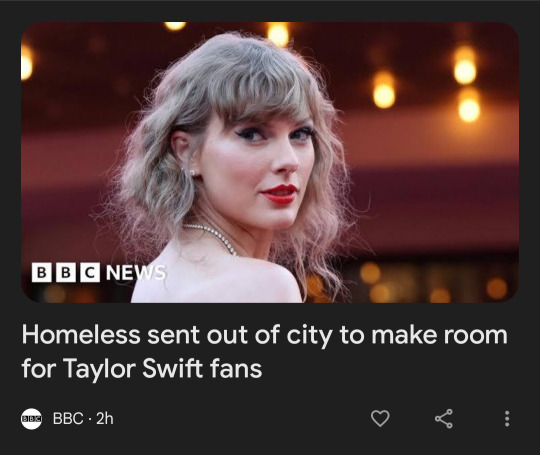
What the a actual fuck.
For reference, Scotland has a legal obligation to provide emergency temporary accommodation for someone homeless, typically hotel rooms. They're being denied this accomodation and shipped off to as far as Newcastle to make room for FUCKING TOURISTS THERE TO SEE SWIFT.
37 notes
·
View notes
Text
No. 36 - Riyadh Air
No, they are not changing their name to Saudi Arabian Airways, but there is a new development on the Saudi Arabian flag carrier front.

That's right, Saudia is dead, sayonara you w-
No. That isn't true, that was a joke. But what isn't a joke is that Riyadh Air is a planned second flag carrier for Saudi Arabia.

That's mostly a joke. Other countries have multiple flag carriers, though that comes with a couple caveats. Usually when this happens one is full-service and international while the other is domestic and/or low cost. The UAE has two flag carriers, but one is Dubai's and the other is Abu Dhabi's, which feels like an important distinction.
Saudi Arabia, on the other hand, just has decided they want to operate a second airline instead of doing the normal thing and putting all their resources into one really good airline. I don't understand it. The plan is to keep Saudia based in Jeddah while Riyadh Air is based in Riyadh...again, plenty of airlines have multiple hubs, so I don't see the point. They claim to be the first "digital-native airline", which is shaped like words yet means nothing (also, take that up with David Neeleman and Breeze). They've nabbed Etihad's old CEO and bought a bunch of 787s, and the stated goal is to become the largest carrier in the Gulf region at an unprecedented blistering pace in order to increase tourism. Given Emirates's numbers...well, it's probably still more likely to happen than a startup airline operating exclusively A380s managing to turn a profit, but that's not saying much.
Anyway, they've got a livery! Apparently this is the first of two, so expect a follow-up post when the second one drops, but for now there's plenty to talk about as is.
Unlike many - nay, most - of the subjects I cover, Riyadh Air has made me do absolutely zero research. You do get modern liveries like jetBlue and Lufthansa with little style guides to weakly attempt to back up their relatively mundane graphic design choices and things like condor and Icelandair's lovely little webpages, but Riyadh Air has done them all at least one if not several better by not only explaining in detail where they got their inspiration but also giving me a high-res 3D model of their airplane that I can rotate and zoom in and out on.
Take care; my computer is fairly underpowered and I do have an absurd number of tabs open most of the time, but this did crash my browser multiple times. Even just opening the main page of their website makes my CPU sound like it's spooling up for takeoff.
Okay. First I want to discuss the logo. They've got a video up on their thought process. I had transcribed it, but it looks better in motion, and thankfully they've stopped making it autoplay (presumably because, as I mentioned, this website absolutely guzzles processor as is) and in the process made it possible for me to simply left-click it off their website and into this post. Don't worry about it killing your browser. It's a normal video in a normal tumblr post without a 100 million dollar website chugging along in the background.
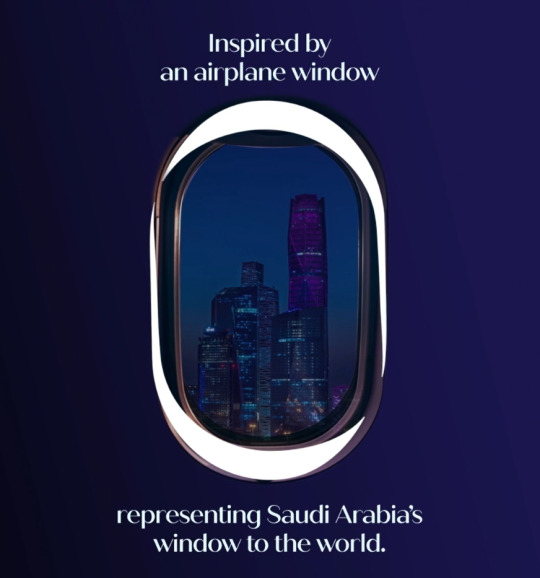


(I've taken some screenshots in case anyone does have trouble with the video.)
Now this is how you design a logo. The airplane window thing feels, in retrospect, so obvious I can't believe nobody had done it yet. I think it pairs gorgeously with the R, and I love that they chose to take inspiration from Arabic calligraphy, which is not only a massive point of pride for cultures which utilize the script but also just generally gorgeous. (It looks a bit like a stretched backwards hamza to me.) The shape of the bird's wing is the part I have the most trouble actually connecting to what I'm seeing, but sure, I'll give it to them. What the heck. This logo is nice.
I mentioned when discussing China Airlines that very few airlines use lavender as a primary color. Well, here's one that does! They actually discuss this on their website as well:
Inspired by the lavender blossoms that carpet Saudi Arabia, we've chosen this color because it symbolizes Saudi generosity and its authentic hospitality.
And this is, again, pretty fantastic. This is a thoughtful choice which isn't lazy or arbitrary. It has the potential to really pack a visual punch, and it does the thing I love when flag carriers do - references a feature of its home nation.

An upside to the fact that the livery page takes eons for my computer to chew on is that I get shown this lovely loading screen, which demonstrates the fantastic combination of blues and purples which make up the full scheme of this airline's colors. I love the combination of these colors. Light saturated colors are rare enough, but to see extremely dark blues and purples together like this is a rare delight. It definitely has the potential to get eyestrainy, but if done well it could look absolutely breathtaking.
But will it be done well? After all, a good idea isn't always well-implemented - see condor - and China Airlines's livery fails for me because it's barely got any lavender! So does Riyadh Air fall into the same pit? Let's check the browser-destroying 3D model they've lovingly provided us.
I love that 3D model, by the way. Instead of looking for a bunch of pictures of airplanes that happen to be in the correct lighting and at the right angle to demonstrate the exact thing I'm attempting to discuss I can just...zoom in while putting the plane at the specific angle I want. Normally I actually try not to rely too heavily on things like style guides because a piece of flat-colored concept art isn't actually going to communicate how a plane looks in motion and with light on it, but this is a really really robust model. Sure, it's not quite as maneuverable as I'd like it to be, it's still not a perfect representation of real life, but it's really well made. It even sways side to side a bit and if you zoom in close enough you can see they bothered to model the external sensors and the engines are even turning! Don't worry about the fact that if you zoom in even further you can tell the engines are just a fan suspended floating in a cowling. They even added ambient engine sounds. This model is so cool it legitimately took me several minutes of turning it around and muttering "wow..." under my breath before I realized the environment it was sitting in was just some very stretched and crunchy jpgs.

Mmm, those reflections.
To be honest, I also just enjoyed playing with this thing. It's almost like having a real model plane, but doesn't cost more money than I have! But enough of that.

So they definitely didn't chicken out when it came to the lavender. This plane is as purple as a Breeze Airways plane is blue (it is very purple). It's not just a purple tube, though. Even from a distance you can see that there's added detail here.
I love the wordmark, first off. They've really committed to the billboard look with this gigantic text in both English and Arabic. I love it. With such an overwhelming main body color it feels prudent to make sure the name is as visible as possible so it doesn't get lost in the shuffle.

And with this gigantic, recognizable logo plastered on the bottom you'd be able to identify it just as well from below (and this is zoomed out as far as the website let me!). In fact, the depth of the design really shines best from below. That's not necessarily a good thing, because your plane does have to be parked sometimes, but it's not a dealbreaker either. I just need to say that this is probably my favorite design for an engine nacelle, ever. It's gorgeous, and you can see in the first picture how well it flows into the main design. They don't go together quite as well from the bottom, and from below the plane does look a bit rear-heavy and the wordmark peering in is a bit awkward, but none of those ruin it. I would be stunned if I saw this fly overhead.
The website provides a few details about the design if you zoom in and click little black dots. It took me ages to realize this. It's neither intuitive nor accessible and I truly despise it, so I've taken the liberty of transcribing the bits that matter.

You can turn this plane in any which way you'd like, zoom in and out, and the details on the bottom never stop being beautiful and coherent. It truly does remind me of calligraphy. As they describe it:
Rooted in our Heritage The controlled, smooth linear profiles make up our signature "Canopy Twist". A perfect balance of our rich local culture and our modern global outlook, connecting the city of Riyadh to the world.
I love the name 'Canopy Twist', to be honest. And I love the design, too. My one criticism of it is the colors. They already have an established secondary shade of purple. That they used the text color for the highlights makes sense, but why couldn't they have used their lavender instead of a third shade of purple? In the quantity used for the underside it feels disconnected from the rest of the livery and they could have fixed that very easily by just...using their already existing secondary shade of purple? I think it would make for a very nice bridge to the tail as well, and it just feels like a colossal missed opportunity.

You may have noticed that the bulk of the fuselage body is a color a bit darker than what might conventionally be considered 'lavender'. This, too, is noted.
Indigo Livery Inspired by the ever-changing colors that paint the sky from dusk till dawn. A symbol of tranquility, harmony and integrity.
(This color is obviously purple, not indigo, but I will not belabor that point.)
I love the description, the idea of the transition between dusk and dawn. Much like the window as a basis for a logo, this makes me go "why in the world has nobody thought of that before? That's brilliant!"

It makes me think a bit more could have been done in the details. Maybe the canopy twist could be a gradient, like the gradient of the sky while the sun is rising? Just a thought.

And ultimately it's the canopy twist that is my only real sticking point with this livery. It is beautiful and unique and well-designed and it is simply a color that sticks out like a sore thumb. It's the only warm thing creeping into a design otherwise full of beautiful cool tones, it has gorgeous flow within itself but breaks up the feeling of consistency through the airframe as a whole, and I just...I really wish it were lavender.

If that's my main issue you can do a lot worse. And overall I do like the Riyadh Air livery. If that one detail was changed, this would easily be an A. This review would be all but uncritical. Except for the fact that it could use a bit of canopy twist up top, too (maybe just a tiny bit on the top of the nose, flowing in the same direction) in order to make the plane feel less rear-heavy (though it already beats out the vast majority of liveries in that sense), the issue with the color is my only big criticism. But it's the main detail of the design, isn't it?
It's wild. So much of the time my reviews are "good details, bad when you step back". But this is the opposite. Fantastic, but there's that one detail that sticks with you. And the details by and large are far from bad too. I mentioned the nacelles, and I think it very elegantly transitions the tail into the body. It would be more elegant if the design on the body was the same lavender, though!

A few more nitpicks: the centering of the logo on the tailfin is a little strange, the tail would look better if it had a bit of a gradient to make it less matte-seeming, and the combined effect of those is very luxury-hotel-towel-monogram. Okay. I'm done complaining.

So it falls short of being one of the best I've ever reviewed, but I still really, really like it. The calligraphy inspiration creates these elegant sweeping lines that are perfectly at home on the 787. The deep purple looks luxurious despite the fact that Riyadh Air doesn't plan to offer first class. It's eyecatching. It's stylish.
And, now that I've covered all this, let's look at the colors in person! That's right, they've already had a plane delivered in full Riyadh Air colors.

The deep purple with the lighter canopy twist, combined with the tiny white dots of the various probes and such, make this plane look like an animal camouflaging itself against the night sky in a place untouched by light pollution. The light lavender contrasts sharply in this particular image, sharply enough that it feels like a slice cut out of the plane.
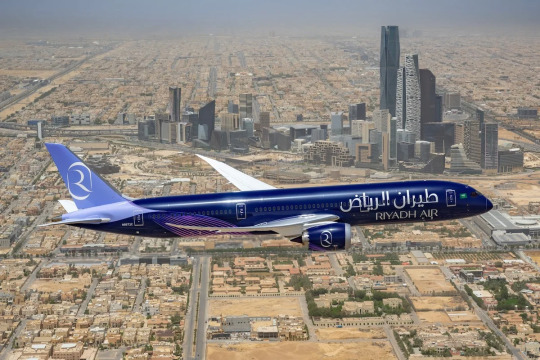
This continues to be an issue from other angles and in other lightings, but the cool-toned light makes this purple look like true indigo and the blueish cast improves the look, giving an almost fluorescent appearance to the transition between the twist and the tail. The way the light reflects off the dark paint makes it look rippling and shifting and alive in a way it never could off white.


In shadow, the plane looks as dark as a city sky. In light, the vibrant purple of a fresh eggplant. This paint job adapts wonderfully to its environment. Much like Vietnam Airlines's, each light brings out a unique beauty.

And sometimes, the tail, detached though it may look, does so in the way a shining arm of a spiral galaxy neatly transitions into the black expanse around it.

Riyadh Air's planes range from ultraviolet to supervoid, but they are never lost in their environment. The principles behind the design remain consistent, and beautiful, and alone in a sky full of planes which refuse to embrace the dark skies they fly in on red-eye journeys.

Ultimately, I think Riyadh Air's livery feels a bit overdesigned. They added one color too many, and a few decisions feel like they don't belong together in the same picture. Just think about the amount of colors here, the balance of major features, and think about Vietnam Airlines, and you'll see what I mean. I'm not a fan of minimalism, but sometimes the only way to keep a story straight is to minimize loose ends. A secret becomes exponentially more likely to be exposed with each new person who learns it.
But before I looked closer, before I zoomed in and out on a little 3D model while my computer screamed, I saw this livery for the first time and my jaw hit the floor. And the average person isn't going to think about this the way I do. Ultimately, my critical eye is usually something I defer to, but I can't argue with the fact that this livery is going to be to someone else what China Airlines is to me. And, like China Airlines, when they come back and look closer at it they'll notice it wasn't as perfect as they thought, but...we've come so far, if this is someone's China Airlines. And as much as I nitpick at details the package counts, too. If you asked me why China Airlines got a C- instead of a D+, my honest reason would be...it struck me enough that I singled it out to begin with, even though that started to fall apart when I looked closer.

Why am I giving Riyadh Air an A- instead of a B+? Because this plane will stun people 5,000 feet below it, and they'll think to themselves that it's the prettiest plane they've ever seen.
#tarmac fashion week#era: 2020s#grade: a-#region: middle east and north africa#region: saudi arabia#riyadh air#flag carriers#at least ostensibly flag carriers.
35 notes
·
View notes
Note
Okay there this game called palworld that kick off recently. And it a monster tamer game like Pokemon… if Pokemon had sex with survival games like Ark survival
Nintendo already acknowledged it https://x.com/Nintendeal/status/1749612269569544679?s=20
Now pokemon fans accuse it of plagiarize pokemon and using ai, it didn’t. But it confused me
If you remember Sony have this exclusive called Ghost of Tsushima that takes place during the Mongolian invasion of Japan and you play as samurai who adapted to  stealth tactiics and iirc. Implied he going to make the first Shinobi clans of Japan
Now when it came out people said “its was the closest thing we can get to a assassin creed set in Japan”
But I saw it more a GOOD competition as AC often get very stagnant due to not have any good rivals series for them to boost them. Yes there are historical 3rd person action games like red dead redemption and mafia. But they are games around certain eras. Obviously that are profitable, but not ac rivals
Obviously red will (unless Ubisoft fuck up hard again) well as it take place during the Unification of Japan. And AC is multiplatform and still big…like two years ago Ireland used ac Valhalla DLC of Ireland for tourism https://www.pcgamer.com/irelands-marketing-itself-with-assassins-creed-valhalla/
And I really hope red give the sense of understanding and show the difference of each feudal regions. As there a anime I own where historical figures such as Shimazu Toyoshia and Oda Nobunaga was sent to a different world. There a running gag that Nobunaga would only have a faint idea of their existence as they only got powerful years after his death. And the Shimazu were basically the country hicks of samurai. So I would live to see those differences among the regions and clans to be used in red
Whoops sorry for the essay, it must be my adhd, it get better as I get older right?
Riiiight?
Hadn't heard about the Japan game yet, Palworld I have sounds fun.
Forum I try to hit up as often as I can, can't terribly often sadly, where a very similar question was broached.
My take was who cares, little more nuanced than that but still.
There's a few different numbers when you ask the question "how many jokes are there" but the number doesn't get too high usually you'll get the number 7.
Only 7 jokes, just different ways of telling the same joke.
Same for video games, only so many types of them out there, just gotta package them differently with different features and such.
As I've said before, Simpsons Road Rage and Hit and Run (maybe just one of them) were basically just Crazy Taxi, which was modeled after other games of that type, just gotta figure out how to add your own little twist to it.
Unhappy people will always find a way to continue to be unhappy, just gotta make sure they don't make you unhappy.
3 notes
·
View notes
Note
Hey so you have a snippet of the next chapter of DES you could share?
I swear to god you can tell when I have opened the DES document recently, because just this morning I was staring at it hoping to write something! I don't have a whole lot of clexa written yet for this chapter but I also don't want to give away the good clexa part of the chapter but sure, here's a little snippet :D
There are still leftovers of last night’s Chinese take out on the counter. Clarke gives them a sniff before deeming them good enough to eat as an early lunch. Plopping herself on her couch and turning on the tv for some background noise Clarke entertains herself with her phone, hoping a message has arrived since she last checked it half an hour ago, fresh out of bed. When nothing but a few notifications that are of no interest stare back at her, the detective throws the phone away from her, trying not to think too much of Lexa’s lack of response last night.
Instead, her mind floats back to the clinic. The broken equipment, the stolen meds that are now long gone. Her mom had money, but she didn’t have clinic rebuilding money, not even close to it. The town would not survive without a clinic. It would either become a poverty ridden place or a ghost town; Clarke has no doubt of it. It was already lucky that the town survived as long as it did after the closing of the mines, after the tourism slowed down with only a hand full of people visiting during the holiday season or the odd hiker in the summer months. Clarke would be fine, she knows that; she’s still young and sure, maybe she would have to swallow her pride and ask her mom for money, but she could make a life for herself out in Polis or maybe somewhere further away.
It’s not herself or even her teammates that concern her though. She worries for the older people of the town, the families with kids like her noisy neighbors, those who can’t just pick up the lives they have built here and settle somewhere new. In a way, she worries for her people. No amount of primary schools would save this town, no amount of empty promises from its mayor would rebuild a community of old miners and poor families. She might resent the way her mother cared for the clinic more than her own daughter, but she knows when to admit that Abby Griffin did good for Arkadia.
Clarke’s playing with the small piece of bamboo that remains at the end of the takeout box when her phone rings and she picks it up, not bothering to look at the caller ID.
“Griffin.” She greets, out of habit.
“Clarke, hello.”
At the sounds of Lexa’s voice, the detective sits up straight and wipes her mouth with the back of her hand.
“Hey, what’s up?” Clarke tries to act casual, pretending she hasn’t been hoping for any kind communication from the other woman since the night before.
“Can you talk right now?”
The question makes Clarke break a sweat, the thought of last nights texting having gone too far on her part and making Lexa break things off with her on the back on her mind.
“Hm, sure.”
“It’s about the clinic.” Lexa says, as if sensing Clarke’s anxiety levels rising.
“Oh.” Right, Lexa’s brunch with the hospital director, she had forgotten about it. In all honesty, she didn’t expect Lexa to remember either, “Please tell me it actually went somewhere.”
There is a guilty silence on the other side of the line and Clarke sighs, defeated.
“I’m sorry Clarke, I tried. But she says that the clinic isn’t driving in any profit and that an investment as big as it needs it’s just no feasible for the hospital.” Lexa admits apologetically, before repeating: “Sorry.”
Clarke immediately feels the need to reassure her that it’s fine, that it’s not her fault at all. She did what she could.
“It’s okay, you tried.” It is all Clarke can muster. This could be it for the clinic and for Arkadia.
“She did suggest a way to raise money.”
“My mo-“
“I know, your mother dislikes being a charity case. But this might be the only way to do it since you refuse to let me donate the money directly.” Lexa interrupts her before she can reiterate her mother’s hate for handouts, “Mrs Williams agreed to do this favor for me and me only, it’s nothing about handouts. She seems to have a strong distaste for your mother actually.”
Clarke scoffs good natured at it, “She wouldn’t be first one.”
Lexa chuckles at Clarke’s response “Luckily for you, she has quite the soft spot for me.” The suggestive tone Lexa uses tells the detective that the soft spot isn’t just for Lexa’s pretty eyes.
“Really?” She tries to keep it playful, burying the jealousy she feels growing inside of her. Their verbal agreement never mentioned exclusivity, so Clarke doesn’t really understand why the idea of someone else liking Lexa would bring out of her a rush of protective jealousy.
When Lexa chuckles heartily, it’s obvious she didn’t bury it deep enough.
“Clarke, she’s in her sixties.”
#there's so a little ✨saucy angsty✨ scene before this one#Im not sure anyone even remembers last chapter but Lexa is in Polis#and she promised clarke she's have a talk with someone on the Polis General Hospital board#but yeah :) this has been written for nearly a year 😅#i am at 3k out of what im hoping for is a 12k chapter!#letter opened#asleepingtiger#au: des
5 notes
·
View notes
Note
im abt to become a conspiracy theorist u gotta listen to me rn
ok Harper is a creep, now matter what. they’re a freak, a weirdo wtv, BUT THEYRE SMART! if ur a doctor u must be smart, and they must also know the ins and outs of a human’s behaviour and brain if they’re able to be employed for therapy and to work at the asylum. this leads me to think that Harper must know what’s going on with the town and their extremely sexual behaviour, they must know about BW and GH. they must know about the night monster and the prayer room. like, they know every single fucked up thing happening in this town and does nothing about it.
this raises a lot of questions for me, like if you knew about the freak in the woods who steals people and fucks them wouldn’t you tell someone? understandable they wouldn’t tell this town’s police but like THE GOVERNMENT? you wouldn’t tell the government of the underground farm and people fucking pigs??? this town is incredibly freaky but ur freakier for not telling someone abt it. they must have a reason not to tell anyone, or, this town is one whole social experiment from the government
I hate how much sense this makes. Like, there's no way Harper knows it all and believes it all, but they probably heard it all, right? They know about the farm and they don't give a shit about the farm. They get to do experiments on the farm. Harper is at the point where they either don't care, or they've grown up here so it doesn't seem out of the ordinary to them.
Also, there is the fact that it's implied that Harper was a patient at the asylum before they became a doctor. People mention several times that Harper is rather young for a doctor. It's more than possible that they aren't medically licensed.
But I don't think the government cares at all. I think the Town government profits too much off the depravity to do anything. People are stated to be visiting from out of town explicitly to to participate in the lewd activities. So, sex tourism. But that's my pet conspiracy. The town being one big experiment? Also v plausible.
27 notes
·
View notes
Text
Tourists or Environmental Terrorists?
"How dare you?!" Those words by Greta Thunberg quickly made news all over the world as she pleaded with the leaders at the United Nations conference in 2019. One brave girl trying to make a big difference. Are we listening, though? Are you making any changes to do your part? The world around us is struggling, and we all need to wake up. Tourism is experiences that leave impressions on people's lives. Connecting with others spreads knowledge and gives an exchange of ideas. The tourism industry has helped improve the lives of millions of people around the world. It creates jobs and brings in money to communities, but it also brings irreversible damages. It could make places throughout the world unsustainable. Without balance, tourism can create adverse environmental, economic, and cultural effects on the planet and humankind.
The environmental impact of tourism has had lasting effects on places around the world. Do tourists belong in the Amazon rainforest? Are they benefiting it or negatively impacting it? Too many people can disrupt the entire ecological state of the environment. People spread disease and leave trash. Should they be trampling in such a majestic place? As it shows in the movie Gringo Trails, the majestic beach of Haad Rin in Thailand went from rarely touched by outsiders to being littered with the trash of thousands of tourists. Is a good time worth it? Is making a few bucks worth losing such beauty?
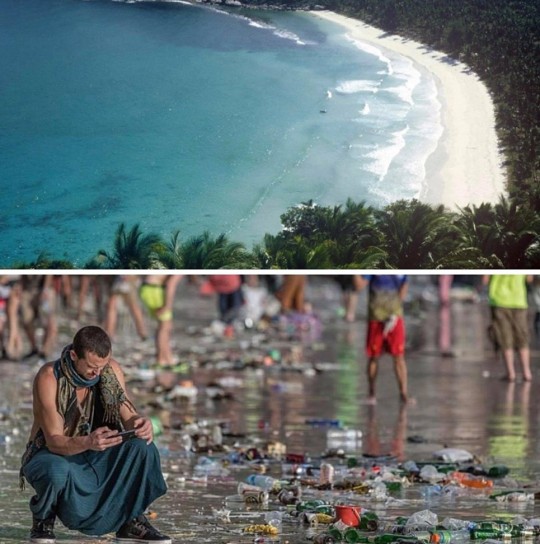
The image above is of the beautiful beach of Haad Rin and the aftermath of one of their New Year’s parties.
As a Michigander, I began to think of my home, and the effects tourism is having. People come from all over the world to visit Michigan every year. According to Travel Michigan, tourists spend around 25 billion per year in Michigan. The top reason people come to Michigan is to see the Great Lakes. The Great Lakes are precious, and when looking at the impact that pollution can have on an industry, we need to do our part to make sure we help follow the Sustainable Development Goals (SDGs). If our lakes are not clean and safe, people aren't going to visit them. For instance, the Flint water crisis. People all over the United States know about the contaminated water in Flint, and they are not going to be booking a trip to visit anytime soon. The hospitality industry is still suffering from this incident that began in 2014. If we don't take care of our Great Lakes, we aren't going to have a selling point anymore. Travelers will avoid us like the plague.
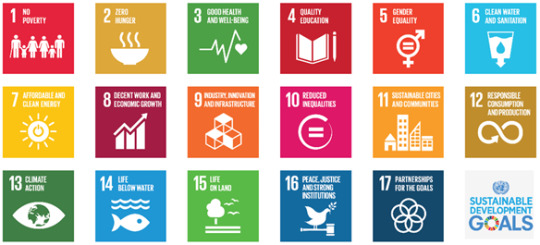
The image of the SDGs was found in a blog by Chris Hoy called, Can the SDGS be achieved by 2030? Chris Hoy shares his thoughts and makes some valid points. His blog can be found here: Can the SDGs be achieved by 2030?
Money makes the world go round. The economic impact that tourism brings to communities is life changing. The movie Gringo Trails shows how one man's terrifying experience created a whole tourism industry for that area. It helped their community and improved the lives of the people. The death toll lowered as the people gained wealth and were able to better themselves. Although tourism brings in money for the short term, what about the long-term effects? Some places aren't sustainable enough to handle so much pressure from people and all that comes with them. How profitable is it for a city that has to deal with the aftermath of the lasting damage that comes with tourists?

Besides the environmental and economic impact of tourism, there's also a cultural impact. "Tourism is really about selling nature and cultural heritage," says National Geographic Traveler editor Costas Christ. Cultural integration brings a swap of knowledge. It has helped the people of this planet grow. As shown in the documentary film Vendemmia, Bhutan, China, follows a philosophy called Gross National Happiness. Ideas like these help spread a culture of peace and unity. The GNP philosophy guides the government in Bhutan. Similar philosophies have been shared for centuries and it has made us better people. With the good influences of culture can also come the bad. People rub off on each other, and sometimes their worst traits influence others. As was also shown in the movie Vendemmia the people of Italy are desperately trying to preserve their culture. Once we immerse with others, we begin to lose a bit of ourselves. We must not lose who we are.
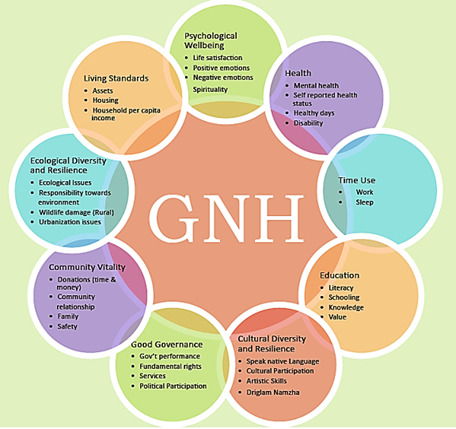
The above image is the Gross National Happiness 9 Domains of Measurement which was found at this site here.
Tourism is not going anywhere, and it all boils down to balance. People need to be educated on the importance of following the customs of other countries. To respect the people and the environment in which they visit. Once tourism is under control, it can be a wonderful experience for everyone. The hospitality industry needs to do its part to follow the SDGs to make sure they are helping make the world a better place. They can take part in better waste programs, recycle, replace old light bulbs, and fix leaking sinks to limit water waste. If the hospitality industry got on board with the world and did their part to follow the SDGs, it would profoundly reduce our carbon footprint. If everyone takes action, we can continue to visit new places or favorite getaways, as long as we remember to be informed tourists and not environmental terrorists.
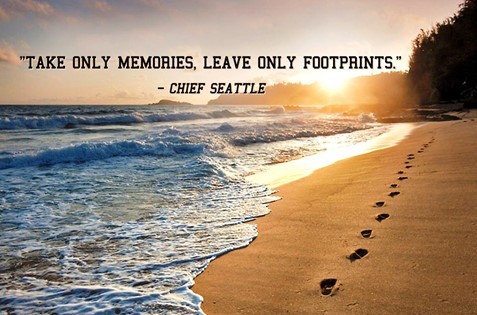
Metta McLeod ~ May 24, 2021
Trending Now: SDG Update - May 24, 2021. http://sdg.iisd.org/sdg-update/
Also Trending Now: Six Young Activists Making Waves. https://www.rte.ie/lifestyle/living/2021/0521/1223023-6-young-climate-activists-making-waves/
Sources:
https://devpolicy.org/can-the-sdgs-be-achieved-by-2030-20150924/
https://gnhusa.org/gross-national-happiness/
https://greenglobaltravel.com/gn/
https://ophi.org.uk/policy/gross-national-happiness-index/
https://www.michiganbusiness.org/press-releases/2019/05/2019-national-travel-and-tourism
https://www.mirror.co.uk/news/world-news/full-moon-party-thailand-ends-7083649
https://www.npr.org/2019/09/23/763452863/transcript-greta
#htmindustry#internationaltourism#gvsu#gringo trails#tourism#environment#greta thunberg#savetheworld
4 notes
·
View notes
Note
If you don't mind me asking, how come you're able to live and work in Japan (and China?)? Where did it al begin? I'm just really curious! Thanks!
I don’t mind, thanks for asking! Turns out I’ve been doing some advising on this topic lately. (Scroll to the bottom for specific advice!)It all began with Digimon…
I’ve always had a history of moving from one obsession to another, starting back with Barney the Dinosaur. Then when I was 11-years-old I found myself very curious about that weird Japanese show on Fox Kids, which looked so different from the Western cartoons I was so fond of. What I caught of it kept me surprised–my stereotypes about it were wrong, the characters and their situations were complicated, and plot had depth? What was this and why did it make me care so much??Well, once I decided I was hooked, I was hooked. Obsessed overnight. I needed to know everything there was to know about it, including the country it came from. Guess I better learn Japanese, I thought.
That thought didn’t go away. I generally got obsessed with anime and Japanese culture, anything I could get my weeby little hands on. Wanting to know everything about Japan led to curiosity about China too, because if you’re going to stretch far back in the origins of Japanese culture, eventually you’re going to get interested in the big collection of nations and time periods known as Ancient China. (Stuff like Fushigi Yuugi and the anime rendition of Condor Hero sure helped drive that interest.)I stayed obsessed with Japan all through my teen years (and started Japanese study in earnest when I was 16) and I chose a college where I could start studying Chinese. It seemed like the natural progression in my studies by that point, but I guess other people thought it was surprising. Or they called me a traitor. (I can tell you now that lots and lots of people wind up studying both.)
Anyway, I went in to college with a pretty wide knowledge of East Asia, but studying it from all sorts of angles, getting good advising in school from nerdy professors, and studying abroad certainly made my understanding more nuanced. Going to a small school where it was easy to stick out also helped me get a good handful of work-study experiences and special attention for my particular passions. (It helps that a couple teachers were enamored with traditional Chinese culture, another loved Heian aesthetics, another wrote a dissertation about the production of shoujo manga, and another loved to give students free food. Now those are my people.)What most people find surprising was that even though I had a heavier course load in Asian studies, my major was Economics. I was concerned about finding work with only nerdy Asian studies, and I felt like I needed to save the world by working at an NGO and sacrificing my personal happiness for the sake of the poor and underprivileged. (I still feel like that, but thankfully there are more ways to support NGOs than only by working in them.) In my research topics I usually had a special focus on developing nations in Asia, and I made sure to get a good understanding of the whole region, not just, like, Edo period gay samurai fanfiction (yeah, that was totally a thing).Well, anyway, I never worked at an NGO. I went to grad school to keep working on my Chinese while keeping up independent Japanese study (including the JLPT), then I worked for the one international company in my hometown doing stuff for their Asian side of business. It was cool if you had any interest in engineering, but I didn’t. I like culture. The weeb shit, as it’s known. All according to keikaku, I became a Coordinator for International Relations on the JET Program (it’s not all English teachers!), and had the time of my life in Matsue (my love for that place is seeeeerious). That’s when I took my wide knowledge of Japan and started getting deeper knowledge, by doing anything and everything, especially practicing naginata, tea ceremony, and competitive kimono dressing. (I like to say I broke the weeb scale a long time ago.) Even among CIRs, who all speak Japanese fairly fluently, I guess I was noteworthy for my nerdy knowledge of obscure pieces of local culture, and my enthusiasm for sharing it. That’s just me being my obsessive self, folks. But yeah, lots of JET Program participants are obsessive and eager to go out and experience things. Aaaahhh, my people. After that, I felt I needed more experience in China, so I got a teaching job (which is relatively easy to do, if you’re a native English speaker). Due to my work schedule and living in Shanghai as opposed to like, Wuyishan or even Hangzhou, I didn’t devote as much as to cultural classes as I originally planned on, but I did practice tea and martial arts throughout my time there, and I continued to work on my Mandarin and gaining obscure cultural knowledge, but especially gaining experience melding with society there. Although it was more overwhelming, I do feel much more competent with my Chinese skills now, and I still love a lot of the culture and have so much more traveling I want to do there. I can still nerd out so hard for so much there.Moving back to Japan felt like a very natural course of things. I know a lot of people who have been happy to be Japan-nerds from a distance, or do the JET Program for a while and then just go back to visit, but at least for now, I don’t see myself happy with only visiting. I have personality flaws, like being very inflexible, that make me work very well in a rigid society like Japan. I’m too used to good convenience stores to live happily without them. I enjoy speaking Japanese all the time instead of taking occasional opportunities. Also, my niche skill set is kind of useless in my part of the US. I did try to find work here, really. That being said, having niche skills means that when I’m useful, I’m super useful. Job searching from outside of Japan was a lot more challenging than applying for the JET Program (which any JET applicant can tell you is not a simple process, but once you’re in, you really appreciate how much they handle for you in matters of moving abroad). It was really, really nerve-wracking to turn down two very good corporate job offers in favor of a somewhat new hotel chain. I really wanted to enter the tourism industry because this feels like the only place (outside of academia) where I can use all my obsessive studies of mainstream and obscure but especially traditional culture, and where my gushing about how much I love stuff is actually useful. Plus, it’ll make use of all three of my languages, not just one or two at a time. I hope this will work out for at least the next few years, if not forever. I also hope that if I live in the US in the future to be closer to family*, then I’ll have enough industry experience to work in hotels here or start a tour company targeted at Asian clients. (*Family is the primary reason I still consider long-term life in America, and it’s a big one, and worrying about them is the hardest part about living abroad. Excessive humidity in a lot of Asia is another reason I might choose to live in the Western US.)But like, now my hobbies are my job. While it won’t be the bulk of it, wearing kimono and performing tea ceremonies is no longer something that makes me cool and special and unexpectedly useful, it’s going to be what I need to be professionally competent in (eeeeeeep). This is the kind of stuff that obsessive teenage Buri would have swooned to know, but also totally expected. Career-Buri is a little more level-headed about it and also very grateful to have these opportunities. So anyway, advice!!—If you think you want to do anything in China or Japan, START STUDYING THE LANGUAGES NOW. Yes, I know they’re difficult. No, there’s no perfect program. Whatever you’re going to use, just do it consistently. Fluency is not actually required for a lot of jobs, but hot damn, some language skills will help. (For reference, I passed N1 of the JLPT before starting JET, and passed HSK5 while I was in grad school. I studied for HSK6 while I was in China and would have had a 50/50 chance of passing, but chose not to because it’s not actually that useful for the price I’d pay for it.)–To get a work visa in either country, 99 times out of a 100, you’re going to need a Bachelor’s degree. Your major is not usually as important as simple proof of graduation. Many places will care about your grades, though, so try to keep them up. –Teaching is still the easiest way to get there. There’s a wealth of programs to recruit you, but I suggest trying to steer clear of places that only provide a stipend instead of a salary, or small dispatch companies with questionable reputations. The JET Program is probably the best way to teach in Japan because of the level of support you get, but I’ve known people who had good experiences on the larger dispatch companies like Altia or Interac as well. For more direct hires, there are English tutoring companies (like English First (EF) or Coco Juku) where you might have students of all ages, as well as companies that focus on very small children (where you’ll basically be a glorified preschool teacher). On that note, many kindergartens and other for-profit education companies (like what I did in China) will hire directly, but your experience can vary widely. Finally, you can also look into international schools, but your teaching credentials will be much more important. Any background in teaching, or TESOL certification, will be a boon to your application (and at some places, your paycheck). –All of these places will want to see that you are a dependable, flexible person. Getting experience abroad, being able to speak frankly about challenges you’ve dealt with, and showing a willingness to go anywhere and do whatever is needed will look really good on your interviews. I say this a JET Program interviewer; the people who displayed the most patience and maturity were the people we felt best about giving a high score to. Those are the people we like to send out into the communities. –As we like to say in the JET Program, every situation is different (ESID for short). That applies to every teaching situation you might yourself in abroad.–You don’t have to be a teacher (after all, I only did JET because of the CIR position, I loved it!!). But you’re going to have to be really competent in whatever else it is you’re doing. Headhunters, such as at Pasona Global (which has branches in many Asian countries), are really, really good to work with, but they are most likely to hook you up with corporate jobs in big cities. If that’s what you want, awesome. (I wound up finding my hotel through a Japanese job searching site specifically for tourism related work. Other industry-specific fields may have their own job hunting sites, possibly in English, possibly not.) Language competency will be a lot more important if you take this route. –If at all possible, STUDY ABROAD!!! Many people will get the experience they want doing this instead of dealing with the frustrations of working and residing abroad. It’s a good way to see how much you love it and decide if the frustrations are worth it. Plus, it really helps your job applications. –Even if you can’t work abroad due to your personal situation, PLEASE TRY TO TRAVEL THERE!!!! When you’re interested in another culture or a foreign language, it means so, sooooo much to be there, even if it’s temporary. I don’t just say this as someone who has chosen tourism as my calling (though I am more than happy to give travel advice), I say this as a passionate nerd. I feel you. I get you. You need this. –Back to studies and stuff though, if you’re going to major in some form of area studies or foreign language, it is difficult to get jobs with that alone. Consider double-majoring in something that will play into that, or which will open other career options. Money is kind of important, especially if you’re going to have to pay for flights across the Pacific.
–That being said, study what you care about too. You know how oddly useful my elective class about Non-Western Theater has been!?!? And if something in anime catches your attention, for goodness sake, you’re on THE INTERNET. If you liked Jubei-chan, go study samurai, if you like Fruits Basket, go learn to make onigiri, if you like Mob Psycho 100, then go—well—um—go work out, being physically healthy is also important!!
Well, anyway, that’s long enough. Good luck to all you nerds out there!! KEN TANAKA LOVES YOU and all that good stuff!!
12 notes
·
View notes
Note
So British Museum must return its collection, lose all income it gives to the budget, make people lose their jobs while returning artefacts to the countries most of which are poorer than England and don't have means to keep those artefacts safe or in good condition?
First off, the assumption that “most” of the countries that the U.K. stole from are unable to maintain their own artifacts is incredibly condescending. Second--so when (and I don’t think it’s an “if”, every country has its dark age) England is no longer able to keep those artifacts to the standards that you find suitable, where should they go? What standards do you operate by? What artifacts are important enough to “save”, and which ones should go with the sands of time? Every answer you give will be arbitrary. There can be no consensus. Is the point of artifacts to preserve them forever, or have people appreciate them? None of the artifacts that the U.K.--and other countries--have stolen were meant to be appreciated or for that matter WORSHIPED by those countries. We have placed an entirely arbitrary meaning on them--something is valuable to us because it’s made of gold. Maybe it was valuable to those who made it because it represented a god or ritual. The fact is that many of the things we insist on preserving were possibly not meant to outlive the culture they come from, especially because many of them are representative of religions that are dead. Sure, we might want to keep them forever because we feel like, but their rightful owners are long dead, and thus the only people who have a right from them are those countrymen descended from the original owners. It breaks my heart that the massive Buddhas of Bamiyan were destroyed by the Taliban; but if they had been moved from their original country of Afghanistan--obviously not possible in their cases--without the country’s permission in an attempt “save” them, that kind of theft is a different type of destruction. It’s culturally destructive.
By the way--so, when these countries are somehow able to care for their own artifacts and art the way you think is proper, will the museum give them back? Hmmmmmmmm.
And guess what? If the British Museum can only keep itself afloat based on stolen artifacts, as you seem to argue, then it SHOULDN’T be kept afloat. That’s painting the British Museum as a criminal enterprise, isn’t it? For that matter, in my opinion any art historian or archeologist who is willingly profiting from stolen artifacts is essentially working in a criminal context--and in fact, curators have been prosecuted for knowingly working with objects of unknown provenance so what makes them so different from people who are working to prevent the repatriation of stolen artifacts like the Elgin marbles, the Koh-i-Noor?
For that matter, why should the U.K. profit from these items while these “poorer countries” that you rather vaguely refer to don’t? Couldn’t they use the money, because England is sooooo capable? Fuck, Greece could use the money tourism surrounding the marbles they’ve had stolen would bring. India could use a bit of cash flow. The marbles were made by Greeks; the Queen’s stolen Indian diamonds were mined in India, surely by Indians. All England did was take them.
And maybe, if the British Museum wasn’t so bullish and profoundly condescending to the countries it stole from, it could work out a deal. Perhaps, like the Italians, the Greeks and the Indians would agree to a long-term loan or an exchange. As I mentioned before, the U.S. gave Italy its artifact back and got some items on loan in exchange. Or hey, maybe some of these countries would be willing to legally sell the items. They aren’t being given a choice, and that’s literally theft.
So if you’re saying “hey Caroline would you rather see cultural artifacts destroyed in their own countries than unrightfully kept by others for perpetuity” then yep. Telling other nations that their items are Special To Us and therefore should be revered by them isn’t right. It’s not right to withhold artifacts because we’re “saving” them. And most of the time, that is a bullshit excuse that we can’t back because fuck, how the hell do we know how these items would be cared for in their home countries today? Most of them haven’t been there for decades or even centuries. The fact is that there is only so much we can do to conserve art and artifacts; 500 years from now, The Last Supper by Leonardo will probably be gone, and I accept that. A meteor could strike the British Museum tomorrow, and everything could be lost. Plenty of masterpieces were lost during World War II because the priority was human life, not art. It’s not that art and artifacts can’t be housed in different nations--but it has to be done legally. Money has to be paid, or trades made.
4 notes
·
View notes